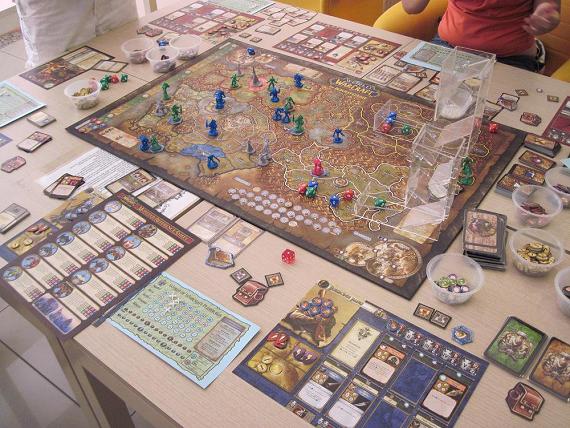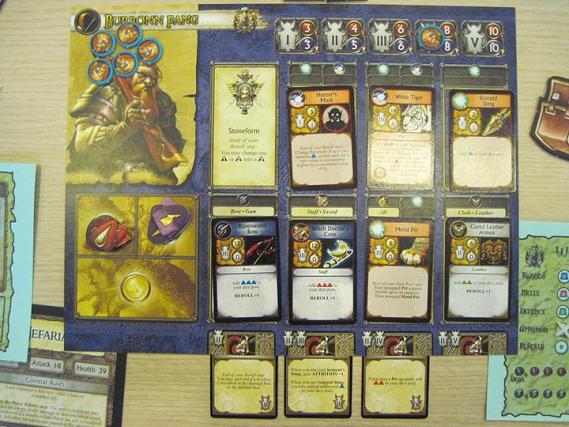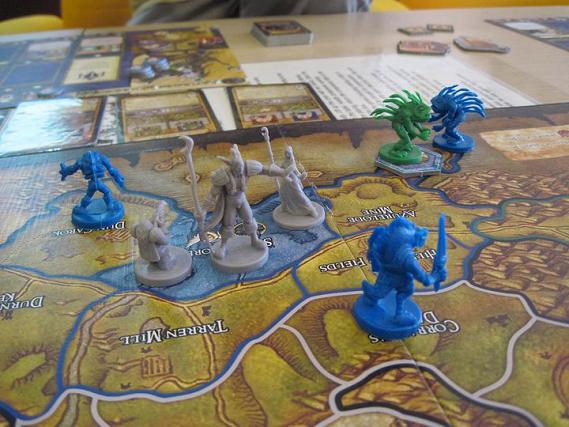
After joking about it for a long time, we recently managed to organize and actually finish a game of World of Warcraft. To tell the truth, I wasn’t terribly enthusiastic about it, especially after Sean continually warned that it would take 10 hours to play to completion. To me, the important thing was just to learn the rules and see how closely the boardgame’s design matches the videogame. As it turned out, not only did we finish the game in under six hours, we also did it with the full six players supported by the game.
Like all adventure games, World of Warcraft has each player control a hero who needs to go forth and perform quests in order to earn experience points and gain magical items. Half of these heroes belong to the Alliance and the other half are part of the Horde. Each team competes with the other to gain power quickly enough to defeat the end boss selected for the session. If both teams fail to successfully defeat the boss by the time the turn counter runs out, then it’s an all out pvp match to the finish to determine which side is the victor.
While the basic structure of the game is fairly intuitive and straightforward, there are way too many little rules to describe in detail here, so here’s a rough summary:
- Each hero gets his own player mat which details that particular hero’s abilities. The mat also has spaces on which you play cards representing both items and class-specific abilities. Each such slot has icons and text on it indicating which cards can legally be played there.

- Each hero has his own deck of cards that describes his class-specific abilities and his talents. Abilities have level prerequisites and must be purchased with money before they’re available. Once they’re available, you must place them on your mat for it to be active. Some abilities cost energy to place on the mat but after that provide a passive effect without costing any more energy. Others don’t cost energy to place but do cost energy each time you activate that ability in combat. Talent cards don’t cost money but you may only select one talent card each time you gain a level. These cards are placed below the mat and once selected may not be changed and is always considered to be active.
- Each faction has its own set of quest cards and you can’t attempt a quest of the opposing faction. Each quest card lists out both the monsters it spawns and the rewards, including experience points, you get for beating the quest. All quests are combat-based. In addition, quest cards also spawn neutral monsters around the map. There are no rewards for beating these but whenever a hero moves into an area with a neutral monster, he is forced to fight it. This is especially annoying as the neutral monsters are actually more powerful than the quest monsters.
- Each hero gets two actions during his faction’s turn. Available actions are moving across one region on the board, initiating a fight against a monster or an enemy hero, resting to regain health and energy, training to spend money to buy ability cards and when in towns, the special town which allows you to both heal and purchase items from the marketplace.
- Combat uses the colored eight-sided dice and lots of it. Items, abilities and talents all give the hero dice of different colors, so equipping a staff for example might give you two red dice. Blue dice represent ranged damage. Red dice represents both melee damage and defense, which absorbs enemy damage while green dice is defense only.

- Only heroes roll dice. The monsters never do. Monsters are represented by fixed statistics which you obtain from a chart plus certain special abilities. A monster’s threat represents the result that you need in order for a roll to be considered a success. If you deal enough damage with just the blue dice to kill a monster, then the combat ends instantly and it doesn’t get to strike back. Otherwise, the monster automatically deals its listed damage back on you, less any red and green dice successes you get, but your red dice successes also deal damage to it simultaneously. If this still doesn’t kill the monster, then combat continues for another round. Finally, heroes sometimes have an attrition rating which is basically free damage against the monster at the end of each combat round.
- One unusual mechanic World of Warcraft uses is spotting dice. This refers to literally spotting, i.e. seeing a particular die result to enable you to do something. For example, my dwarf had Stoneform, which allowed him to spot a die result of either 1 or 2 and turn it into a 3, which comes in handy to avoid the special abilities of many monsters which are often activated when you roll 1s and 2s. My hunter also had a talent which allowed him to spot an 8 on a blue die to instantly deal one damage to a monster, without changing what the original result does.
- The rules remain basically the same if more than one hero teams up to defeat a monster. Each player rolls all his dice and if the cumulative blue dice alone is enough to kill the monster, then that’s it. Otherwise, the heroes are free to distribute the monster’s remaining damage among themselves however they wish. Naturally, when heroes do this, they must also divide the rewards among themselves.

That’s about all the rules I care to explain. Next up are thoughts and observations from our session:
- Naturally, this game is all about moving out to perform quests all over the map as quickly as possible. This means avoiding the blue monsters whenever feasible and planning your movement in such a way that you can easily move on to complete another quest after you finish one. The fastest way of course is to spread out to have each hero take on a different quest but that vastly increases the risk of dying, which wastes a lot of time. This was what happened to Ah Fatt on the Horde team as he attempted a quest solo and died on the very first turn.
- The character development and combat systems are complex enough that it’s quite fun to figure out good combinations of abilities and talents to use. Gaining levels and items is always addictive, especially since in this game gaining a level instantly restores your hero to full health and energy. Still, the game only goes up to level five and our Alliance team beat the final boss by the time we reached level 4, so it’s not like you get to level up very often.
- Unfortunately you spend so much time fiddling around with your own mat that you barely know what the other players are doing. My hunter started out with ranged combat upgrades but then went for big and tough pets that allowed me to tank lots of damage. But beyond the fact that Sean had a Druid and Aaron had a warlock, I had zero idea of how they chose to develop their characters. It’s just that much worse with the other team. I knew that Shan had a glass cannon mage who could conveniently polymorph blue monsters blocking her way but I can’t even remember which classes Chee Wee and Ah Fatt had.

- We only had pvp occur once when Sean, while low on health, walked right into the group of all three Horde heroes on purpose. He wanted to finish a quest they were standing right on top of and gambled that it was worth it even if he died. We also had some event cards come up which let us move around some blue monsters, so each team would move in such a way as to cause maximum inconvenience to the other team. Apart from that, there was zero interaction between the teams. Maybe sometimes, you’d look at the experience point track, notice that the other team is ahead and choose to take a bit more risk to try to catch up.
- Our Alliance team successfully took down the end boss when we were all at level 4. It turned out to be easier than expected as we could easily have survived for another round or two. I guess if you have only two players per team, you’d need to wait until level 5. We got a leg up mainly because we took a bit more risk than the Horde team in splitting up and doing quests individually whereas they spent most of their time grouped together.
While the experience wasn’t as bad as I’d feared and things went quickly enough that it never felt boring, I can’t say that I feel like playing it again. In the same time that we spent on the boardgame, a full group would easily be able to work through a couple of dungeons in the videogame, seeing and doing way more things along the way. Heck, with how the game is tuned these days, a group of five levelling together would blow through the levels like they were nothing. So while the World of Warcraft boardgame is commendable in how it tries to recreate the levelling and questing aspect of the videogame, it’s sort of solving a problem that doesn’t exist, unless, well, you’re really dead set against videogames or something.
2 Responses to “World of Warcraft”
I got this and I think it’s sux. I’m trading it out but no one wants it.
Heh, I wouldn’t exactly say it sucks. It’s an adventure boardgame. Either you enjoy the genre or you don’t. There isn’t really much room for innovation in this genre given what Magic Realm accomplished over 30 years ago. Personally I get the appeal of the genre all that time ago, but it seems to me that modern videogames and MMOs especially have made it completely obsolete.
Leave a Reply